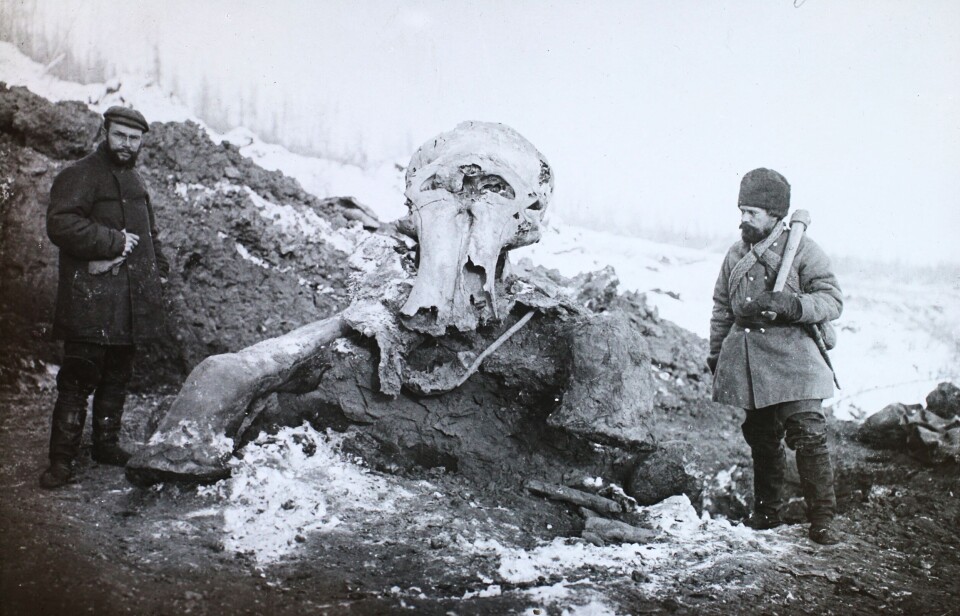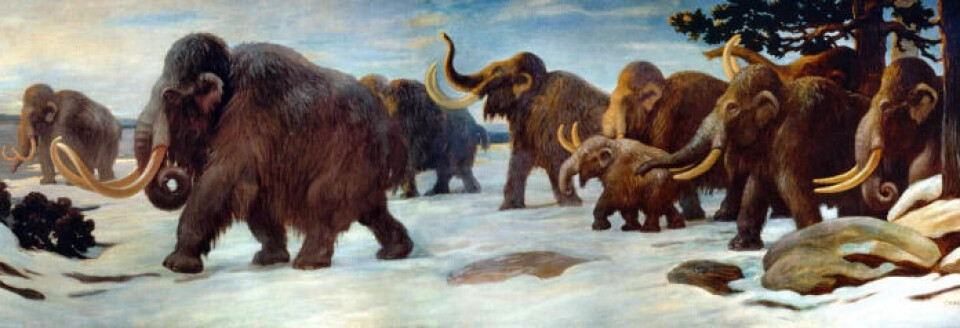
For a long time people thought fossils were animals and dragons drowned in Noah’s flood. Then scientists discovered the Ice Age
In a new book, Reidar Müller describes the history of the climate and the people who pieced it together.
It was once a common belief that the Earth was around 6,000 years old.
This world view began to be discredited in the 18th century. Rock layers with fossils hinted at a long, long prehistory.
Over the past 200 years, scientists have shed more and more light on the Earth's 4.5 billion-year-old history.
That story is also about climate: We now know the Earth was covered in ice for millions of years at a time before advanced life came into existence. And that the Arctic was covered by forest 50 million years ago. At that time, alligators and monitor lizards lived in northern Canada and Germany was home to a subtropical jungle.
In his new book "Ild og is — En kort innføring I klimaets historie” (Fire and ice — A short introduction to the history of the climate), geologist Reidar Müller describes how the climate has changed over the course of the Earth's history.
One topic he writes about is ice ages.

A fussy dragon
The Earth has gone through a series of ice ages over the last 2.6 million years.
The discovery of strange animals in the north gave people hints that the world had once been different.
Müller describes an episode in his book about people in Klagenfurt, Austria, who found what they thought was a dragon skull.
According to legend, the dragon had lived in the river Glan. When the weather was wild and wet, people could hear it roar. The city's leaders got tired of it. A knight was tasked with slaying the dragon.
The dragon was enticed to bite a hook upon which there was an ox, and the knight killed the monster.
In 1334, a huge skull was found in a gravel deposit in the city.
“They thought it had belonged to the dragon,” Müller said to sciencenorway.no.
The deluge
This story was not unique. In several other places during the Middle Ages in Europe, bones of giants and mythical beasts were put on display.
People thought they might have been killed by knights, or that they had died in Noah’s flood.
“Gradually, people began to understand that the fossil finds didn’t actually originate from giants and dragons. They descended from mammoths, rhinoceroses or even dinosaurs,” Müller said.
In the 18th century, the German researcher Peter Simon Pallas collected bones from Siberia. He realized they came from elephants and rhinos, not monsters.
But then a new problem arose. How on Earth had these animals ended up in the cold north?
Pallas thought that a huge flood was the best explanation.
“Floods or the deluge have been very important as an explanation,” Müller said.
“Floods have been used to explain why fossils of animals that are not found today were found in certain areas,” he said.
Others believed that the elephants had escaped from military campaigns, including from Hannibal's army when he crossed the Alps and marched towards Italy.
Thought the earth gradually cooled
The Frenchman Comte de Buffon advocated another theory in the 18th century: that the Earth had been warmer earlier and gradually became colder. The rhinos and elephants had probably moved to warmer areas when the climate became colder.
He experimented with red-hot iron balls and measured how long it took for them to cool.
Based on that, he calculated that the Earth was between 75,000 and 3 million years old. This went against the biblical interpretation of the time, which was not without risk.
The theory was called ‘the cooling Earth’, Müller said.
At the end of the 18th century, another Frenchman, Georges Cuvier, believed that the elephants and rhinoceroses of Siberia were extinct species. That too was controversial. After all, God had created the world to be complete and perfect.
Carcasses with fur
Soon, mammoth carcasses with fur were found in the permafrost of Siberia.
“Then people realized that they were not the same species as African elephants,” Müller said.
“No elephants had escaped from Hannibal's journey across the Alps, for example. There were actually animals that lived in these areas in a climate that was colder than today,” he said.
The skull found in Klagenfurt was also not from a dragon, but a woolly rhinoceros.

Important discovery in Norway
The Danish-Norwegian geologist Jens Esmark was among the scientists who established that the Earth had once been colder.
In 1823 he was conducting field work in western Norway. At the outlet of the Lyse fjord, he noticed Vassryggen, a long ridge that dams up Lake Haukalivatnet. The ridge is made of stone, sand and gravel.
Later, Esmark studied an offshoot of Jostedalsbreen and discovered a similar ridge of gravel by the glacier.
“They found an end moraine that was clearly deposited by the glacier,” Müller said.
Esmark saw the similarity with Vassryggen. He concluded this must mean that there were once glaciers all the way down to the sea.
Discoveries had also been made in Switzerland and other places during the same period, which indicated that glaciers had once been larger.
In 1840, the Swiss glaciologist Louis Agassiz put forward the theory that there had been ice ages.
Today, scientists believe that there have been at least 40 ice ages in the past 2.6 million years. Each ice age was followed by short, warmer interglacial periods. We live in an interglacial period today.
For a long time, however, the cause of the ice ages was a mystery.
The Earth's journey around the Sun set the pace
The Serbian Milutin Milanković deserves the credit for advancing the theory that would eventually prove to be correct. Others had looked into the same idea before. Milanković worked on the theory until 1930.
Milanković calculated how the Earth's orbit (whether it is more round or elliptical), its inclination (how tilted the axis is) and its precession (the wobble) change.
He found a pattern in which these factors change over 100,000, 41,000 and 19,000 to 24,000 years. The changes lead to different amounts of solar radiation at different latitudes.
These small differences in solar radiation set the stage for the ice ages. Other mechanisms enhance the cooling and subsequent warming.
Milanković's theory was confirmed in the 1970s. Scientists retrieved samples from seafloor sediments. The samples covered the last 450,000 years. They were able to establish that the Earth’s temperature had varied in the cycles that Milanković calculated.
The ice ages have occurred approximately 100,000 years apart. Over a million years ago, the 41,000-year cycle was most important.
Wooded expanse
You don't have to go that far back in time to find exciting periods in the Earth's climate history. Müller thinks one of the most fascinating times is our own interglacial period.
Nine thousand years ago, the northern hemisphere was closer to the sun in summer than today, as a result of the Milanković cycles. At that time Snaufjellet, a mountain that is now above treeline and populated by moss, heather and dwarf birch, was covered with forest.
The summers were warmer, which is what determines the treeline, Müller says.
“It is fascinating that Norway has changed so quickly, even in our interglacial period. It’s amazing there was a forest on Snaufjellet, and that the glaciers melted away,” Müller said.
At the same time, the monsoon moved further into the Sahara. Today's desert landscape was greener and wetter.
“Rock carvings of crocodiles have been found far into the hyper-dry Sahara today,” he said.
The dynamic climate during our interglacial period was perhaps important for the first civilizations, says Müller.
“I find those connections very exciting,” he said.
Not black and white
Müller also writes about how large-scale volcanism, the movements of the continents, weathering of rocks and other happenings have affected the climate in the past.
Müller hopes that his readers will be left with a better understanding of how complex the climate is.
“It always surprises me that people make such black-and-white statements about the climate. Either there are climate deniers, or there are people who believe that life on Earth will perish in the near future solely because of climate change. I hope my book contributes to a more knowledge-based debate,” he said.
CO2 levels are now the highest they have been in three million years.
“I think it is also important to underscore that climate history tells us that we are carrying out a huge experiment by spewing such large amounts of greenhouse gases into the atmosphere over such a short period. These emissions are happening at a very rapid pace, also from a geological perspective,” he said.
———
Read the Norwegian version of this article at forskning.no
































